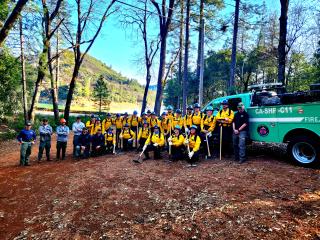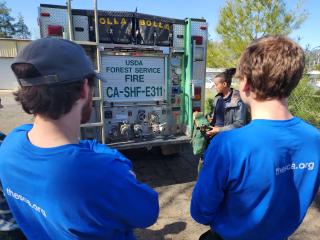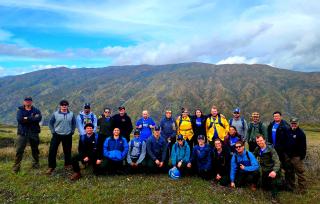Student Conservation Association Wildland Fire Academy members ready to make big impacts

WASHINGTON, D.C.—Twenty-two sweaty young adults grin as they cross the finish line of their first work capacity test on the Shasta-Trinity National Forest. These young men and women, ages 18-30, are part of a partnership designed to strengthen the U.S. Department of Agriculture’s Forest Service’s capacity to confront the wildfire crisis and increase the number of women and other underrepresented groups entering wildland firefighting professions.
The Wildland Fire Academy, a partnership between the Student Conservation Association and Forest Service funded by the Infrastructure Investment and Jobs Act, launched its first full cohort in March 2024. The academy is one of two national programs started as part of the American Climate Corps. Academy members will complete fuels reduction work across Wildfire Crisis Strategy landscapes on the Klamath, Shasta-Trinity, Payette, Uinta-Wasatch-Cache, Tahoe and Los Padres national forests.

“We are proud to bring on such a diverse, passionate group of individuals from all over the country. They are eager to make a difference to reduce wildfire risk to communities by reducing hazardous fuels on public lands at a most dire time in history,” said Ginelle Heller, Forest Service National Partnership Office workforce development program coordinator. “This program represents the strong partnership and commitment between the SCA and the Forest Service to build future leaders to confront the wildfire crisis.”
Academy crews received two-and-a-half weeks of robust training on the Shasta-Trinity National Forest, led by the Trinity Interagency Hotshot Crew and Region 5 and Washington Office staff members. Training included wildland firefighter, sawyer, wilderness first aid and Forest Service orientation. Other highlights included a staff ride at the Rattlesnake Fire led by the Mendocino Hotshots, a tour of the Redding Smokejumper base, and a career café with a variety of specialists from the Shasta-Trinity National Forest.
Cristian Rodriguez, a 21-year-old crew member from Utah, said, “I’ve enjoyed learning about how many opportunities there are within this field and within the Forest Service. My favorite part about the training is for sure all the hands-on stuff—that’s one of the ways I learn the best.”
At the end of the training, crew members walk away with a “red card,” formally known as an Incident Qualification Card. This document certifies that an individual has the skills, experience and training to work in wildland fire operations. Members begin their work as interns on districts for two months under the direction of experienced Forest Service supervisors. They then transition to SCA-led, four-person fuels crews for the next three months.
Crews will deploy to multiple Wildfire Crisis Strategy landscapes over the duration of the partnership.
“Over the next four years, SCA will continue to scale the program with the Forest Service. Our collective impact is poised to make significant strides in reducing fuels and restoring burn impacts on forest lands in communities most at risk,” said Toby Bokum-Fauth, Student Conservation Association vice president of partnerships. “Through this initiative, we will continue to ramp up our support for the Forest Service’s ‘Wildfire Crisis Strategy,’ all while offering invaluable hands-on experience, certificates and trainings to create the next generation of fire and fuels professionals that better reflect the diversity of the communities we serve.”

